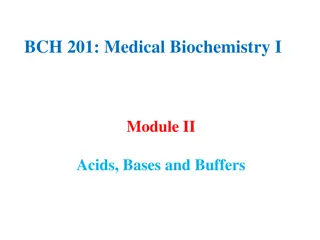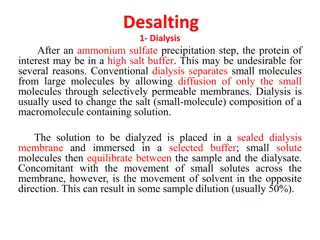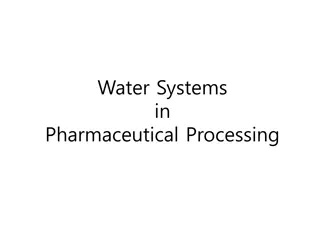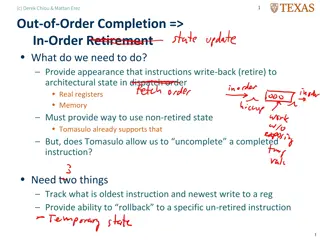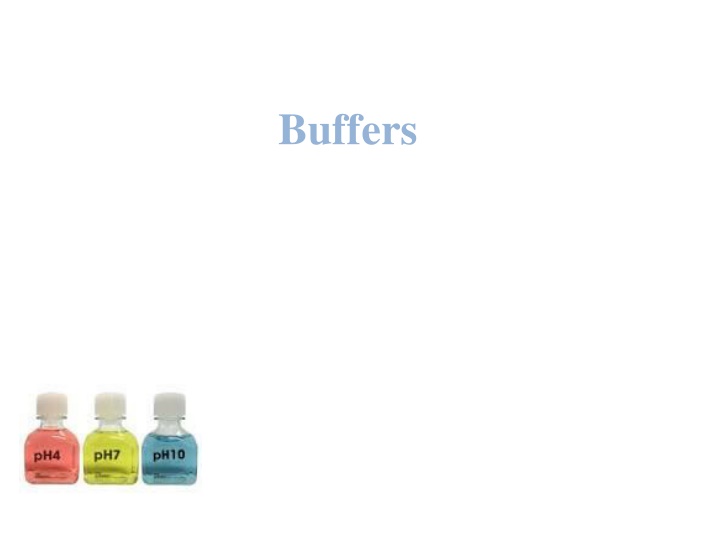
Titration of Weak Acids with Strong Bases
Learn about the process of titrating weak acids with strong bases, how pH levels are affected, and calculations involved. Follow a detailed example to understand the concept better.
Download Presentation

Please find below an Image/Link to download the presentation.
The content on the website is provided AS IS for your information and personal use only. It may not be sold, licensed, or shared on other websites without obtaining consent from the author. If you encounter any issues during the download, it is possible that the publisher has removed the file from their server.
You are allowed to download the files provided on this website for personal or commercial use, subject to the condition that they are used lawfully. All files are the property of their respective owners.
The content on the website is provided AS IS for your information and personal use only. It may not be sold, licensed, or shared on other websites without obtaining consent from the author.
E N D
Presentation Transcript
Buffers buffers
Titration of a Weak Acid When a strong acid is titrated with a strong base, the pH at any point is determined by the concentration of un-titrated acid or excess base. When a weak acid is titrated with a strong base, the weak acid dissociates to yield a small amount of H+.
Titration of a Weak Acid Continue HA H++ A- When OH-ions are added H++ OH- H2O The equilibrium between the weak acid and its ions is disrupted. Thus, more HA ionizes and the newly produced H+ ions neutralized by more OH-ions until all of the H+ originally present is neutralized. HA + OH- H2O+ A-
Titration of a Weak Acid Continue Example: Calculate the appropriate values and draw the curve for the titration of 500ml of 0.1M weak acid HA with 0.1M KOH, Ka= 10-5, p Ka= 5 ? A) at the start point: before any addition of any base pH = ( pKa+ p [HA]) pH = ( 5+ 1) pH = 3 B) at any point during the titration: after the addition of 100ml KOH pKa + log [A-] [HA] pH =
Titration of a Weak Acid Continue Since KOH + HA KA + H2O No. of moles of KOH added = M * V = 0.1 * 0.1 No. of moles of original HA= M * V = 0.1 * 0.5 1 mole of OH- will react with 1 mole of HA to produces 1 mole of salt. Thus, the no. of moles of salt produced = 0.01 mole. No. of moles of remaining HA added=moles of HA originally present moles of HA titrated to salt. = 0.05 0.01 = 0.04 mole pKa + log [A-] [HA] = 0.01 mole = 0.05mole pH =
Titration of a Weak Acid Continue pKa + log [A-] [HA] pH = pH = 5 + log ( 0.01 / 0.04) pH = 4.4 C) at any point during the titration: after the addition of 250ml KOH No. of moles of KOH added = M * V = 0.1 * 0.25 = 0.025 mole No. of moles of original HA= M * V = 0.1 * 0.5 = 0.05mole 1 mole of OH- will react with 1 mole of HA to produces 1 mole of salt. Thus, the no. of moles of salt produced = 0.025 mole. No. of moles of remaining HA added= moles of HA originally present moles of HA titrated to salt. = 0.05 0.025 = 0.025 mole
Titration of a Weak Acid Continue pKa + log [A-] [HA] pH = pH = 5 + log ( 0.025 / 0.025) pH = 5 Here the [A-] = [HA] thus, pH = pKa D) at any point during the titration: after the addition of 375ml KOH No. of moles of KOH added = M * V = 0.1 * 0.375 = 0.0375 mole No. of moles of original HA= M * V = 0.1 * 0.5 = 0.05mole 1 mole of OH- will react with 1 mole of HA to produces 1 mole of salt. Thus, the no. of moles of salt produced = 0.0375 mole. No. of moles of remaining HA added= moles of HA originally present moles of HA titrated to salt. = 0.05 0.0375 = 0.0125 mole
Titration of a Weak Acid Continue pKa + log [A-] [HA] pH = pH = 5 + log ( 0.0375/ 0.0125) pH = 5.48 E) at the end point of the titration: after the addition of 500ml KOH No. of moles of KOH added = M * V = 0.1 * 0.5 = 0.05 mole No. of moles of original HA= M * V = 0.1 * 0.5 = 0.05mole 1 mole of OH- will react with 1 mole of HA to produces 1 mole of salt. Thus, the no. of moles of salt produced = 0.05 mole. The final volume of the solution = 500+500 = 1000ml
Titration of a Weak Acid Continue [A-] = 0.05/1 = 0.05 M p [A-] = -log 0.05 = 1.3 pOH = ( pKb + p [A-]) = ( 9 + 1.3) = 5.15 pH= pKw pOH = 14- 5.15 =8.85
Titration of a Weak Acid Continue From the previous example: A) All HA is in the form of CH3COOH B) [CH3COOH] > [CH3COO-] C) [CH3COOH] = [CH3COO-] D) [CH3COOH] < [CH3COO-] E) All as CH3COO-
Buffers Buffer is a solution which resist large changes in the pH by partially absorbing addition of the H+ or OH- ions to the system. Acidic buffer: mixture of weak acid and its salt of strong base. Basic buffers: mixture of weak base and its salt of strong acid. Buffers resist changes in pH upon the addition of limited amounts H+ of or OH-. Buffer pH do changes upon the addition of H+ of or OH- but the change is much less than that would occur in case of buffer absence.
Mechanism of Action of Buffers Example of buffer CH3COOH / CH3COO- When H+ is added to the buffer: CH3COO- + H+ CH3COOH When OH- is added to the buffer: CH3COOH + OH- CH3COO- + H2O The buffer absorb the effect of H+ or OH- as possible as it can.
Buffer Capacity The ability of a buffer to resist changes in the pH is referred to as a buffer capacity. The no. of moles of H+ that must be added to one liter of the buffer in order to decrease the pH by one unit. The no. of moles of OH- that must be added to one liter of the buffer in order to increase the pH by one unit.
Buffer Capacity Continue ? =2.3??[H+][C] ??+[HA] 2 ???? = 0.575 [C] In the equation: ? = buffer capacity [H+] = hydrogen ion concentration of the buffer [C]= total concentration of buffer components = [HA] + [A-] . https://www.youtube.com/watch?v=g_ZK2ABUjvA https://www.youtube.com/watch?v=g_ZK2ABUjvA





